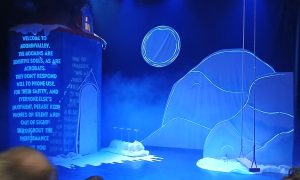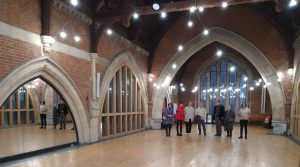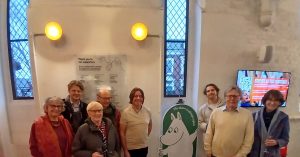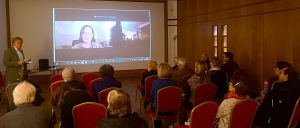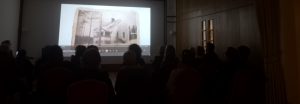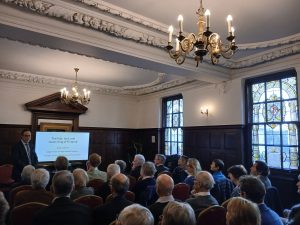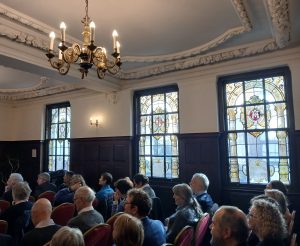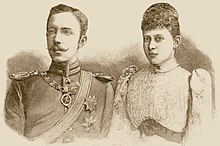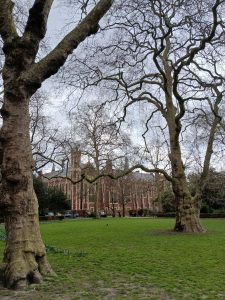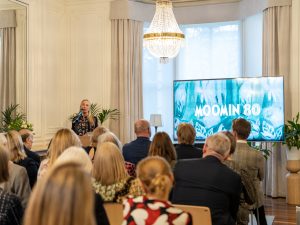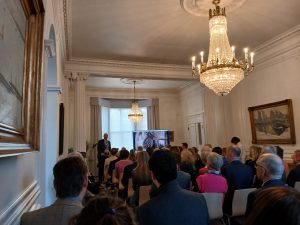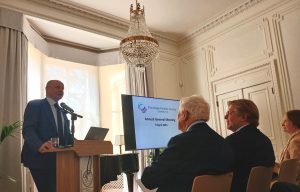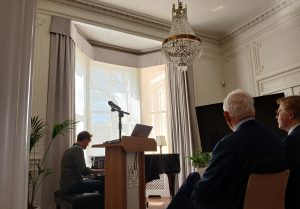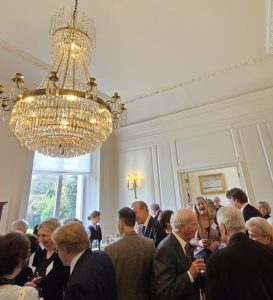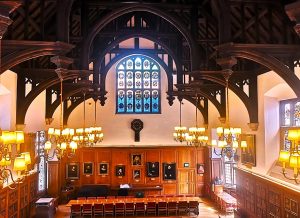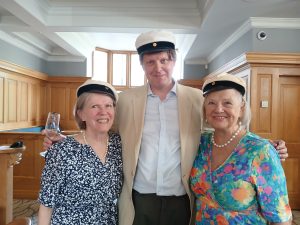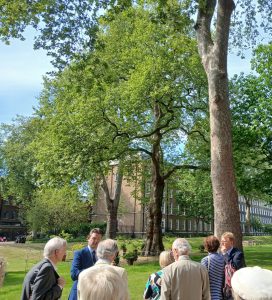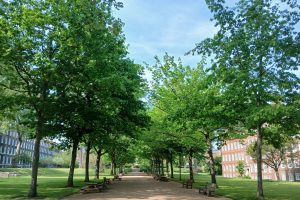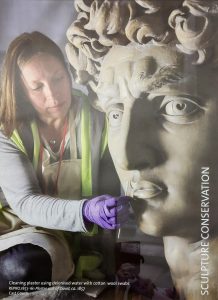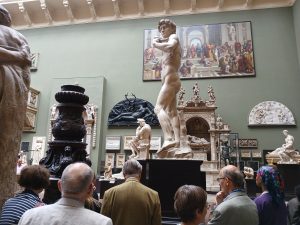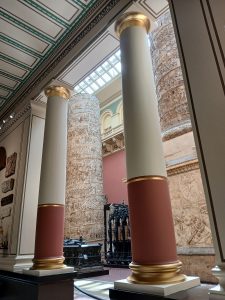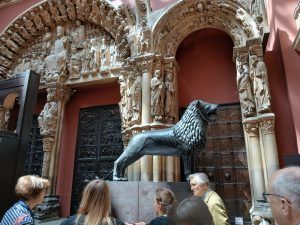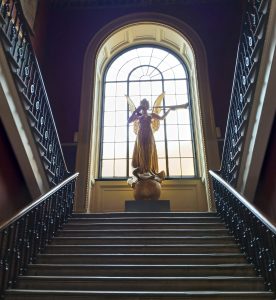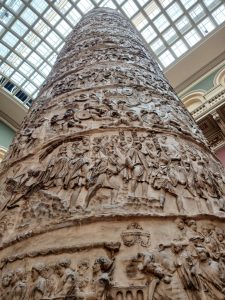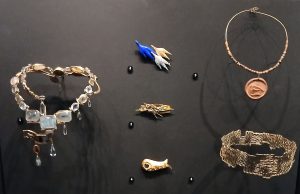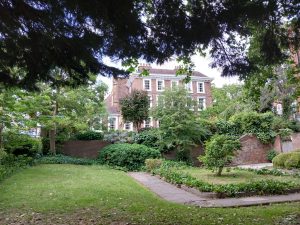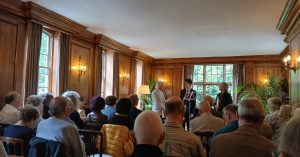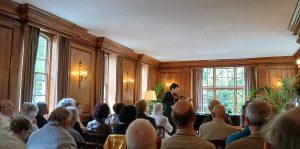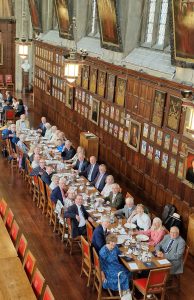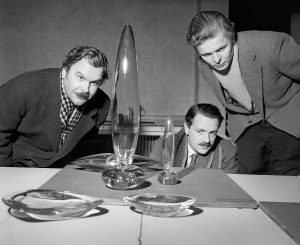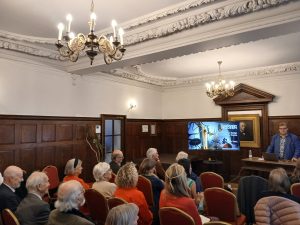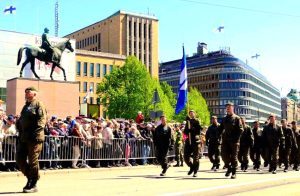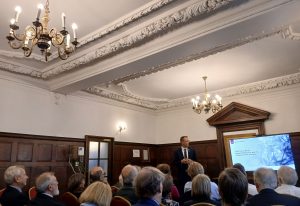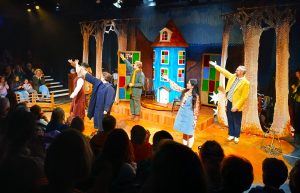On 5 January 2025, a group of our members enjoyed a performance of Christmas Comes to Moominvalley at Jacksons Lane, in Highgate, north London, celebrating the 80th anniversary of the global phenomenon of the Moomins in the year of the 50th birthday of Jacksons Lane in the beautiful Edwardian Grade II listed former Wesleyan Methodist church.
Christmas Comes to Moominvalley is Jackson Lane’s new adaptation of Tove Jansson’s classic tale, The Fir Tree. The Moomins are woken up from their winter sleep to be told that ‘Christmas’ is coming. The only trouble is, the puzzled Moomins have no idea who, or what ‘Christmas’ is…
The audience included all ages and it was especially lovely to see how excited the youngest members of the audience were. The performance of circus acrobats was also breath taking.
After the performance we had drinks in the foyer and a tour of the building with the Artistic Director Adrian Berry.
On 14 January 2025, we enjoyed a film projection and talk by Kirsten Adkins, a filmmaker based in Glasgow, of her film Singing the Wooden House.
A journey to a border zone, in search of a wooden house, provokes questions on selfhood and national identity, place and belonging and the lasting implications of flight and return.
Kirsten Adkins describes her film: Rajavyöhyke translates from Finnish to English as border zone. Signs that line an 800-mile border, cross the forests and lakes of Finland and Russia. They operate as a modest indication of who belongs, and where. In April 2023, I travelled with a camera to a wooden house near the border town of Imatra, in the region of Carelia. The area was fought over during the Winter War between 1939 and 1940, and the Continuation War between 1941 and 1944. My mother and her family, who lived in the house, were neither Finnish nor Russian. They were exiled to Sweden, settled in Stockholm and they never returned: some 400,000 people were evacuated as the border between Finland and the Soviet Union shifted. With a new war in Europe, rajavyöhyke articulates an increasing tension between opposing geopolitical forces. This year, Finland joined NATO. Sanctions were issued against Russia and the wooden house now owned by a family from St Petersburg is once again abandoned. In November 2023, at the time of writing, Finland closed the entire border to Russia, for the first time in its history. There is an unsettling stillness and marked absence of people near the rajavyöhyke. A few voices carry across the lakes on the border – it is unclear whether they are Russian or Finnish.
Kirsten Adkins is an artist and filmmaker who has a professional background in documentary television. Kirsten’s filmmaking and writing practice is concerned with stories of home, belonging and migration. She is currently working on a forthcoming edited anthology (Routledge 2024), and curated project space that is concerned with ways that artists and filmmakers use hybrid practices in film, poetry, song and dance to provoke questions on place, identity and belonging. Her interdisciplinary practice is informed by her work in news and factual programmes at the BBC where she worked as a producer and director. Kirsten has exhibited, presented, published, and broadcast nationally and internationally. She teaches filmmaking and artists moving image at the University of Glasgow. See also: Kirsten Adkins
On 13 March 2025, Professor David Goldsmith gave a talk to a full room on Friedrich Karl of Hesse – the first, last, and never King of Finland. We heard about a fascinating event in Finnish history and also learned about the partly surprising background to it.
We know the richly storied accounts of Swedish, Danish, and Norwegian royalty and nobility dating back over 1000 years to Viking times. But, what about Finland – did the Finns and Finland ever have their own King, or were they fated to ‘make do’ by sharing other people’s sovereigns?
The picture is of Landgraf Friedrich Karl of Hesse (1.5.1868 – 28.5.1940), and his wife Landgräfin Margarethe, Princess of Prussia (1872-1954).
Prince Friedrich Karl, Landgraf of Hesse, was the brother-in-law of Kaiser Wilhelm II, having married Kaiser Wilhelm’s sister, Princess Margarethe (grand-daughter of Queen Victoria) in January 1893. At the fateful moments in 1918, Friedrich Karl was 50, married, with six sons (two sets of twins, one set died fighting in WW1). Prince Friedrich Karl was elected King of Finland on 9 October 1918, but renounced the throne just 66 days later on 14 December 1918. He never even managed to get to Finland at all! However, was he in fact ever legally elected? By whom? How? Under what circumstances, and constitution? We delved into a little-known curious by-way of history, which in many ways resembles the way that Sweden acquired the Royal House of Bernadotte, in 1809/1810. We were taken through the maze of muddle, mishap and machination, which characterised the accession (or not) of Friedrich Karl of Hesse – the first, last, and never-King of Finland.
A pre-talk reception and lunch was held at Lincoln’s Inn. This event was organised in cooperation with the Anglo-Swedish Society.
On 3 April 2025, Sophia Jansson gave a talk about her aunt the legendary “Tove Jansson: Painter, Illustrator, Storyteller” to mark the 80th anniversary of the Moomins at the Finnish Residence at Kensington Palace Gardens. We are grateful to the H.E. The Ambassador for hosting us for this talk and the reception afterwards.
This event was organised in cooperation with the Embassy of Finland in London, the Finnish Institute and the Anglo-Swedish Society.
Our Annual General Meeting took place at the Finnish Residence on 9 April 2025. We remain grateful to H.E. The Ambassador, Mr Jukka Siukosaari for hosting us again. This would be the last time he would attend our AGM as Hon. President of the Society, as by the time of our next AGM there will be a new Finnish Ambassador in London.
Sir Paul Lever stepped down as President of the Society after a decade of service for which he was duly thanked. He was succeeded by Dr Valerie Caton, who was British Ambassador in Helsinki from 2006 to 2010.
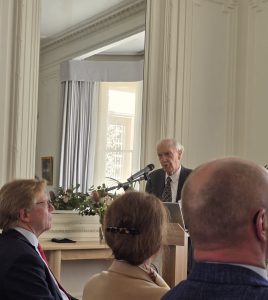
Hon. Treasurer John Hulin presenting his report to the AGM, having also served as treasurer for a decade (with a new treasurer expected soon), carrying out his work most thoroughly
The formal business of the AGM was followed by a beautiful performance on the grand piano by one of our Members, the London-based Anglo-Finn Olli Cunningham, playing one of his own compositions called Credo. A reception followed in the spring sunshine.
Our Vappu-Valborg Lunch took place on 1 May 2025 at The Honourable Society of Gray’s Inn with welcome drinks at the Bridge Bar.
We were honoured and delighted by the Master Treasurer of the Inn for 2025, The Rt Hon Lady Justice Geraldine Andrews DBE, PC, inviting us all to join her on the High Table for our lunch in Gray’s Inn Hall. Our Guest of Honour was HH Prince Christian de Vartavan. We remain grateful to John Boyd, KC, a Bencher of Gray’s Inn and a Member of the Anglo-Finnish Society, for facilitating this venue.
Some of us wore our Finnish Student Caps as is customary in Finland on 1 May. After the lunch we were also treated to a tour of the Inn, including the garden ‘the Walks’ and the Library.
Gray’s Inn has been home to lawyers since before 1388 AD and is today one of the four Inns of Court responsible for the education and training of barristers before and after their Call to the Bar. The sixteenth century was known as the “Golden Age” of the Inn, when Queen Elizabeth I herself was the Inn’s Patron. In this period the Inn was renowned for its “Shows” and there can be little doubt that William Shakespeare played in Gray’s Inn Hall, where his patron, Lord Southampton was also a member. Tradition claims that the Great Screen was built from the timbers of the Nuestra Senora del Rosario, the flagship of the Andalucian Squadron of the Spanish Armada in 1588. Some of the exquisite stained-glass windows in the Hall date back to 1462. Master of the Bench of Gray’s Inn, Sir Winston Churchill and Mr Franklin Roosevelt (then Minister of Munitions and Assistant Secretary of the United States Navy, respectively) first met in 1918 at the high table within Gray’s Inn Hall.
On 20 May 2025, we organised a quickly sold-out guided museum and conservation studio tour for a group of 20 of our members at the Victoria and Albert Museum.
We had a general tour of the museum given by the Museum’s expert guides and a specific behind-the-scenes tour of the conservation studio led by Finnish Conservator Johanna Puisto, showing some work-in-progress on objects for upcoming exhibitions and displays.
The detail and delicacy involved in conservation was fascinating to discover. Even those of us who have been visiting the Victoria and Albert Museum for years discovered much we have missed before in the rich and varied collections with some new additions like Beyoncé’s ‘Papillon ring’ by G (Glenn Spiro) of 2014 with shimmering wings encrusted with vivid green tsavorites and edged with diamonds and hinges that allow the wings to flutter – so magically glittering that it is difficult to take a photograph of it but you can see it here ‘Papillon’ ring by G (Glenn Spiro) · V&A – with more to discover in the imminently opening new V&A Storehouse in Stratford – see V&A East.
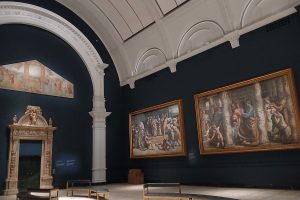
The Raphael Cartoons are a set of seven full-scale designs for tapestry painted by Raphael (1483 – 1520)
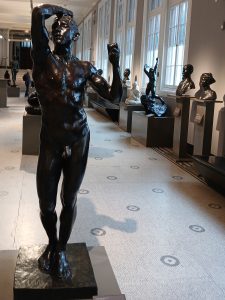
There is a surprisingly large collection of Auguste Rodin’s sculptures at the Museum first stuck in the UK during the First World War…
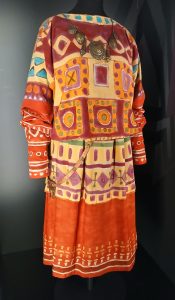
We were also fascinated to discover this unusual ballet costume for the Maiden in Stravinsky’s ballet Le Sacre du Printemps in 1913 – heavy wool costumes making it very difficult for the dancers to perform…
On Sunday, 8 June 2025, The United Kingdom Sibelius Society (‘UKSS’) held a concert at Burgh House, Hampstead. Jenny Stern, piano, and Emmanuel Bach, violin, performed a wide selection of Sibelius’s music for piano and for violin and piano, including the Sonatine for Violin and Piano, Op.80, the Menuetto Op.81 No.5, Danses Champêtres, Op.106 and Six Humoresques for Violin and Piano. It was fascinating to discover some of the lesser known works of Sibelius.
We are delighted to have supported this event by selling out an allocation of over 20 tickets and we remain grateful to the UK Sibelius Society for welcoming us again.
On 24 June 2025, the Anglo-Nordic Societies’ Midsummer Lunch and Reception took place at The Honourable Society of Lincoln’s Inn for a second time this year after last year’s success. We had as our Guests of Honour H.E. The Ambassador of Finland Mr Jukka Siukosaari and and his wife Mrs Mariella Siukosaari who have been very supportive of our Society. We were also honoured and delighted to have with us the Treasurer of Lincoln’s Inn for 2025, Hon. Sir Paul Morgan. It was a sunny warm day.
On 23 September 2025, James Vaux gave a talk on ‘Scandinavian Modern’: Nordic Design Behind the Scenes, after a pre-talk reception and lunch in Lincoln’s Inn.
We heard how Finnish designers played a huge part in the ‘Scandinavian Modern’ movement of the 1950s. It was a style that took America and Europe by storm with its cool functionality, natural materials and organic curves. But, lurking behind the scenes, were hidden hands and powerful political projects. It was not just the social democratic urge to change consumer taste into something more rational. Nordic design became embroiled in a US plot to unite the West under one ‘democratic’ design idiom, to unsettle the Soviet bloc, and to demonstrate that America had culture and taste. Indeed, Finland covertly used the opportunity to display its Western credentials to America at a time of Finlandisation.
This illustrated talk featured designers and architects including Alvar and Aino Aalto, Tapio Wirkkala, Timo Sarpaneva, Bruno Mathsson, Josef Frank, Astrid Sampe, Hans Wegner, Finn Juhl, Arne Jacobsen, Charles and Ray Eames and George Nelson. It looked at major design exhibitions between 1930 and 1960 in Stockholm, Berlin, the United States, Helsinki, Helsingborg and Moscow, and it examined why modernism became such a useful Cold War tool, why ‘Finnish’ design suddenly became ‘Scandinavian’, and how a functionalist movement for the masses was transformed into an elite luxury style.
Our speaker James Vaux is a member of the Anglo-Finnish Society and an Accredited Arts Society Lecturer, specialising in Nordic art and design and modernism more generally. In 2025 he has 50 talks all over the country and hopes to spread a wider understanding of Nordic culture. He holds a recent MA in Scandinavian Studies (Language, Culture and History) from UCL, where his dissertation was on the politics of Nordic design in the Cold War. He has also studied design at the Inchbald School and Mid-Century Modern at Sotheby’s Institute. Before retirement he was a managing director and global partner of the international bank Rothschild & Co. He was head of the bank’s Nordic operations, which he founded together with Pehr Gyllenhammar. He lived and worked in Stockholm, and amongst other roles across the region he acted as an adviser to the Finnish, Danish and Swedish Ministries of Finance.
On 24 October 2025, the Finnish Defence Attaché Captain (Navy) Juha Ravanti gave a talk on Developing Finnish Defence. He shared current situational information and estimations about it. We also enjoyed a pre-talk reception and lunch at Lincoln’s Inn.
On 2 November 2025, a group of our members enjoyed a performance with a pre-show talk by Hans Jacob Hoeglund, the Swedish Composer of the new musical Moominvalley in November, performing from 23 Oct 2025 until 16 Nov 2025 at Upstairs at the Gatehouse, Highgate Village, London.

